
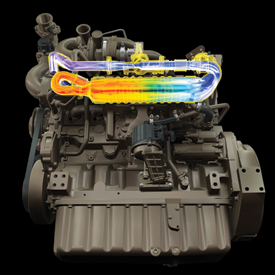 PowerTech PSS 9.0L engine
PowerTech PSS 9.0L engineThe John Deere exhaust filter is integrated into the engine design and electronics to provide a seamless operator experience. The engine control unit (ECU) and exhaust temperature management (ETM) system work together to continuously regenerate the exhaust filter using a natural cleaning process sometimes referred to as passive regeneration.
If natural filter cleaning cannot be achieved based on temperature, load, and speed, then particulate matter (PM) must be removed using an automatic cleaning process sometimes referred to as active regeneration. In most cases, filter cleaning does not impact machine operation or require operator involvement. Higher pressures created by our Final Tier 4 (FT4)/Stage IV high-pressure fuel system extend intervals between automatic cleanings.
How EGR works
EGR reduces the high temperatures where nitrogen oxide (NOx) compounds are formed in the engine cylinders by replacing excess oxygen with a prescribed amount of cooled exhaust gas.
Exhaust gases contain more carbon dioxide than oxygen. The EGR valve, in conjunction with the venturi and ECU, allows a controlled amount of exhaust gas to enter the intake manifold to mix with the incoming fresh air. Replacing excess oxygen with cooled exhaust gas leads to lower combustion temperatures, creating less NOx. In addition, EGR allows for advanced timing, leading to optimal performance of the engine, maximizing fuel economy.
Flow of exhaust during engine operation
Exhaust airflow enters into the EGR cooler from the exhaust manifold near the turbocharger.
Based on engine load, air temperatures, and rpm, the ECU opens or closes the EGR valve, allowing a measured percentage of exhaust gas to enter the intake manifold.
The gases mix with the rest of the incoming air from the turbocharger and aftercooler before entering the cylinders.
The following diagrams illustrate how air flows through the engine (PSS).
For added performance and efficiency, the engine passes the exhaust gases through an EGR cooler before it enters the engine.
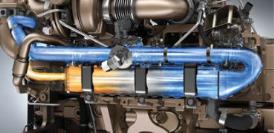 PSS EGR
PSS EGRPSS 9.0L and 13.5L FT4 technology
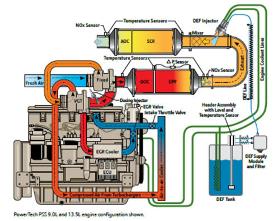 PowerTech PSS Final Tier 4 technology
PowerTech PSS Final Tier 4 technology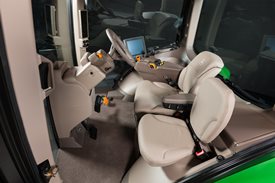 CommandView III cab
CommandView III cabThe standard CommandView III cab offers unsurpassed visibility, operator comfort, control placement, and ride and sound quality.
Features:
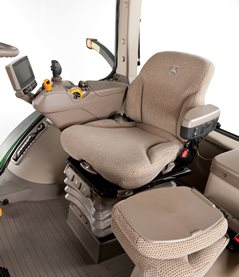 ComfortCommand seat
ComfortCommand seatComfortCommand seat improves ride quality and helps to reduce operator fatigue
Features include:
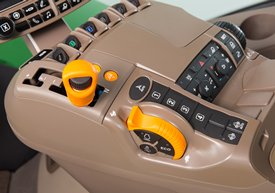 CommandARM controls
CommandARM controlsJohn Deere 9 Family Tractors feature the CommandARM with integrated Generation 4 CommandCenter display. The control layout of the CommandARM utilizes a clean and efficient design which groups controls by function and builds upon John Deere’s history of intuitive and ergonomic control placement and operation. The design of the CommandARM allows for a 40-degree right seat swivel and adjustable positioning matching the operator’s preference.
Controls located on the CommandARM include:
Hydraulic controls utilize fingertip paddle pots for raise/lower and extend/retract functions.
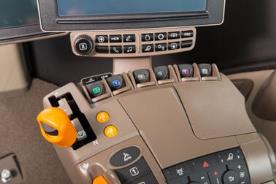 Fingertip paddle pots
Fingertip paddle potsThrottle
The throttle design incorporates buttons which control FieldCruise speed, and transmission eco settings.
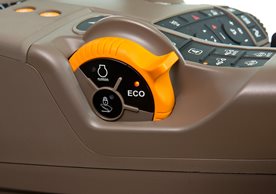 Throttle
ThrottleTractor function controls
Located just to the right of the throttle is the Auto-Trac activation button and four sequence controls for iTEC functions. Behind the iTEC sequence controls there are buttons which control the activation and deactivation of differential lock. Differential lock can also be activated by the foot switch on the cab floor.
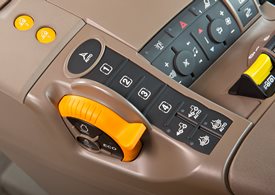 AutoTrac resume and iTEC strip
AutoTrac resume and iTEC stripControls for radio, lights, rotary beacon (if equipped), hazard flashers, and HVAC system are located to the center-right on the CommandARM, along with power take-off (PTO) for rear PTO.
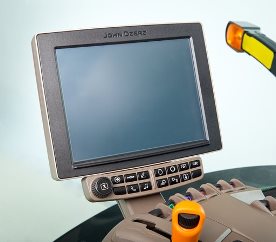 Generation 4 CommandCenter
Generation 4 CommandCenterThe Generation 4 CommandCenters features fast adjustment of tractor functions and controls and are integrated into the CommandARM to create a seamless control center.
The following functions can be adjusted and accessed using the CommandCenter display:
The Generation 4 CommandCenter systems have the capability of Remote Display Access (RDA). RDA allows improved communication between an offsite farm manager or dealer and the equipment operator. The user can view exactly what the operator sees on the GreenStar™ 3 2630 Display and Generation 4 CommandCenter from almost any internet-connected device. RDA is available on the 4600 and 4100 CommandCenter and allows for an increase in productivity with quicker problem resolution. By using RDA, the cost of operation will decrease due to reduced labor and travel costs, and maximum efficiency will increase profit.
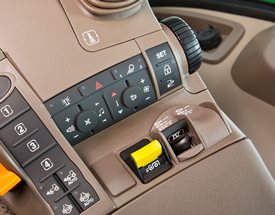 Radio, HVAC, hazard flashers, and PTO controls
Radio, HVAC, hazard flashers, and PTO controlsSeat swivel
The design of the CommandARM allows for up to 40 degrees of right-hand seat swivel.
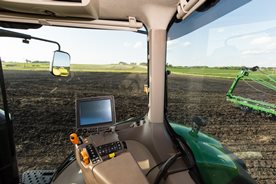 Seat swivel
Seat swivel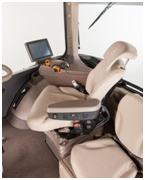 40-degree seat swivel shown
40-degree seat swivel shownThe e18 transmission delivers smooth shifting and intuitive controls in a reliable 18-speed PowerShift transmission. The e18 transmission with enhanced Efficiency Manager is standard equipment on all 9 Family Tractors.
The e18 has evolved from more than 50 years of John Deere PowerShift technology. With more automatic features, the e18 is easy to operate for all levels of operators and operations. It features three modes of operation, full AUTO, custom, and manual modes. Full AUTO and custom modes manage the engine and transmission to match the desired ground speed to the field conditions. These two modes are ideal for most conditions and take the guess work out of operation. Manual mode is perfect for operators looking to operate the e18 like a traditional PowerShift by bump shifting and managing the engine throttle to their liking.
As the next generation of PowerShift technology, the e18 delivers the strength to handle sudden, high-torque power loads while maintaining responsive, quick, and smooth shifts.
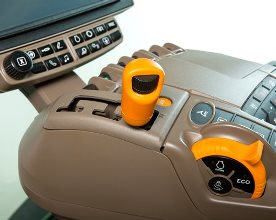 Shift lever and hand throttle
Shift lever and hand throttle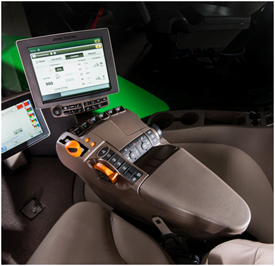 254-mm (10-in.) Generation 4 CommandCenter
254-mm (10-in.) Generation 4 CommandCenterThe CommandCenter is the central information system for tractors and allows the operator to program various settings tailored to a specific operation.
To access the tractor’s transmission settings, press the transmission shortcut button on the CommandCenter shortcut bar.
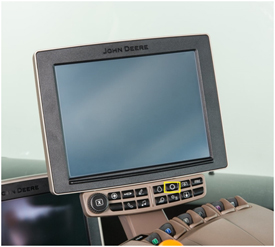 CommandCenter transmission shortcut button
CommandCenter transmission shortcut buttonOperating modes
The e18 application settings employ three modes to take full advantage of the engine-transmission communication: Full AUTO mode, custom mode, and manual mode.
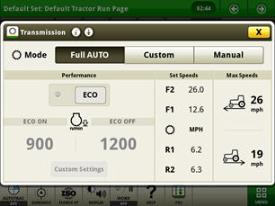 Full AUTO main page
Full AUTO main pageFull AUTO mode manages the tractor’s engine and transmission inputs to reach and maintain the desired ground speed set by the operator. This means the tractor will manage shifts and engine rpm to operate at the most efficient level possible. Operators have the ability to set the maximum forward and reverse speeds for their particular applications. In full AUTO mode the operator can adjust the desired ground speed in two ways, by conducting a traditional bump shift or by rotating the dial on the thumb wheel.
When shifting in full AUTO mode, the transmission shifts set speeds and does not always shift gears, meaning the transmission may not necessarily shift gears if it can reach the desired ground speed with a slightly higher or lower engine rpm. Efficiency Manager is automatically engaged while operating in full AUTO mode. As a result, shifting will not take the tractor out of Efficiency Manager in full AUTO mode.
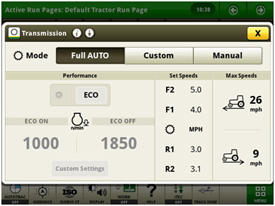 e18 custom transmission page
e18 custom transmission pageCustom mode operates similar to full AUTO mode but allows operators to adjust operating parameters to meet a specific operation. It also has the ability to activate eco mode for a higher level of operation.
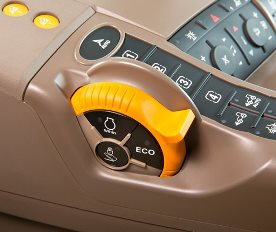 Eco button
Eco button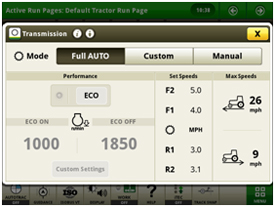 Display screen
Display screenEco allows two minimum engine speeds to be set. Operators can turn eco on and off by either pushing the eco button on the side of the throttle or by selecting eco in the transmission settings page of the CommandCenter controls. For example, operators may choose to turn eco on during transport to utilize a lower minimum engine speed and then turn eco off while operating in the field where a higher minimum engine speed is desired.
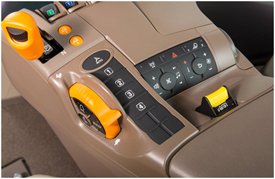 Set speed buttons and set speed adjuster
Set speed buttons and set speed adjusterEfficiency Manager is automatically enabled in auto and custom modes. Efficiency Manager can be turned on in manual mode by selecting the set speed one or set speed two button on the CommandARM™ console. The set speed adjuster on the top of the single-lever gear selector allows the operator to dial in the desired ground speed to establish set speed one or two. Once engaged, Efficiency Manager will manage the engine rpm and gear selection to maintain the desired working speed. To reach the desired set speed, the throttle must be set to full engine rpm.
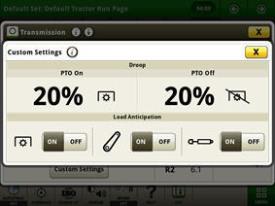 Custom settings page
Custom settings pageIn the advanced settings page, operators can customize the auto shift engine speed droop as a percentage of the full engine speed. In addition, the load anticipation feature can be enabled for the hitch engagement, hydraulic engagement, or both.
Manual mode
Manual mode operates very similarly to a traditional PowerShift transmission with Efficiency Manager.
In manual mode the operator manages the engine and transmission inputs by controlling the shift lever and hand throttle.
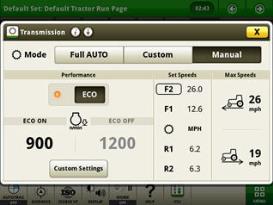 Manual mode page
Manual mode page e18 operation
e18 operationSetting start-up gears
The 9 Family Tractors default to 7F and 2R at start up. However, these default start-up gears can be adjusted from 1-13F and 1-3R through the CommandCenter. Refer to the operator’s manual for additional information.
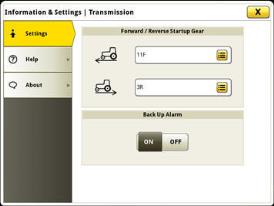 Start-up gears in advanced settings
Start-up gears in advanced settings9R Series Tractor - e18-speed chart for PowerShift transmission with Efficiency Manager
9R table
Group 47 tires | Group 48 tires | |||
Tire size | (480R46, 20.8R42, 520R42, 620R42, 710R38) | (480R50, 520R46, 620R46, 710R42, 800R38) | ||
Engine (rpm) | 2100 | 2100 | ||
18-speed gear | km/h | mph | km/h | mph |
Forward gears | ||||
F1 | 4.0 | 2.5 | 4.2 | 2.6 |
F2 | 4.8 | 3.0 | 5.0 | 3.1 |
F3 | 5.3 | 3.3 | 5.6 | 3.5 |
F4 | 5.9 | 3.7 | 6.2 | 3.9 |
F5 | 6.5 | 4.0 | 6.8 | 4.3 |
F6 | 7.3 | 4.5 | 7.6 | 4.8 |
F7 | 8.0 | 5.0 | 8.5 | 5.3 |
F8 | 9.0 | 5.6 | 9.5 | 5.9 |
F9 | 9.9 | 6.1 | 10.4 | 6.5 |
F10 | 11.0 | 6.9 | 11.6 | 7.2 |
F11 | 12.2 | 7.6 | 12.9 | 8.0 |
F12 | 13.5 | 8.4 | 14.2 | 8.8 |
F13 | 15.0 | 9.3 | 15.8 | 9.8 |
F14 | 16.6 | 10.3 | 17.5 | 10.9 |
F15 | 20.5 | 12.8 | 21.6 | 13.4 |
F16 | 25.3 | 15.7 | 26.6 | 16.5 |
F17 | 31.2 | 19.4 | 32.9 | 20.4 |
F18 | 38.5 | 23.9 | 40.5 | 25.2 |
Reverse gears | ||||
R1 | 3.9 | 2.4 | 4.1 | 2.5 |
R2 | 5.3 | 3.3 | 5.6 | 3.5 |
R3 | 5.9 | 3.7 | 6.2 | 3.9 |
R4 | 8.0 | 5.0 | 8.5 | 5.3 |
R5 | 9.0 | 5.6 | 9.5 | 5.9 |
R6 | 12.2 | 7.6 | 12.9 | 8.0 |
Group 47 tire based on 710/70R38
Group 48 tire based on 800/80R38
9RT and 9RX Series Tractor - e18-speed chart for PowerShift transmission with Efficiency Manager
9RT and 9RX table
| 9RT | 9RX | ||
Engine (rpm) | 2100 | 2100 | ||
18-speed gear | km/h | mph | km/h | mph |
Forward gears |
|
|
|
|
F1 | 4.0 | 2.5 | 4.0 | 2.5 |
F2 | 5.0 | 3.1 | 4.9 | 3.0 |
F3 | 5.5 | 3.4 | 5.5 | 3.4 |
F4 | 6.1 | 3.8 | 6.1 | 3.8 |
F5 | 6.8 | 4.2 | 6.7 | 4.2 |
F6 | 7.6 | 4.7 | 7.5 | 4.7 |
F7 | 8.4 | 5.2 | 8.3 | 5.2 |
F8 | 9.3 | 5.8 | 9.2 | 5.7 |
F9 | 10.3 | 6.4 | 10.2 | 6.3 |
F10 | 11.4 | 7.1 | 11.4 | 7.1 |
F11 | 12.6 | 7.8 | 12.6 | 7.8 |
F12 | 14.1 | 8.7 | 14.0 | 8.7 |
F13 | 15.6 | 9.7 | 15.5 | 9.6 |
F14 | 17.3 | 10.7 | 17.2 | 10.3 |
F15 | 21.4 | 13.3 | 21.3 | 13.2 |
F16 | 26.3 | 16.3 | 26.2 | 16.3 |
F17 | 32.3 | 20.1 | 32.2 | 20.0 |
F18 | 39.8 | 24.7 | 39.6 | 24.6 |
Reverse gears |
|
|
|
|
R1 | 4.0 | 2.5 | 4.0 | 2.5 |
R2 | 5.5 | 3.4 | 5.5 | 3.4 |
R3 | 6.1 | 3.3 | 6.1 | 3.8 |
R4 | 7.3 | 3.8 | 8.3 | 5.2 |
R5 | 9.3 | 5.8 | 9.2 | 5.7 |
R6 | 12.6 | 7.8 | 12.6 | 10.3 |
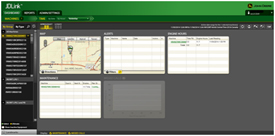 JDLink Dashboard
JDLink DashboardJDLink is the John Deere telematics system designed for operators and managers who desire to take their operations to the next level of productivity and efficiency without leaving the office. Whether it is receiving an e-mail or text message, users can manage the operation in real-time without being in the cab. Using the power of JDLink can optimize productivity, increase uptime, and boost profits with JDLink information all accessible from a laptop, desktop, or mobile device.
JDLink Ultimate provides enhanced machine performance and utilization information that can only be achieved through direct communication with on-board machine controllers. Utilizing John Deere-exclusive telematics technology, users can remotely link to Ultimate-compatible machines to achieve a new level of optimization.
NOTE: Mobile device compatibility and functionality varies.
Monitor assets, performance, and more with JDLink:
For more information on JDLink activations and subscriptions, visit www.StellarSupport.com.
NOTE: JDLink is not available in all geographic regions.
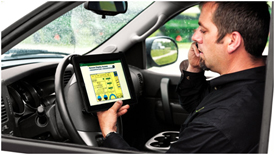 Service ADVISOR
Service ADVISORService ADVISOR diagnostics greatly assist in reducing service costs and downtime. It allows the John Deere service technician to readily extract vital information about tractor malfunctions through the Service ADVISOR data port. Diagnostic codes and controller area network (CAN) bus statistics stored by the tractor and visible in the CommandCenter™ display are used by service technicians to isolate, identify, and resolve problems.
Diagnostics and CAN bus statistics are not normally used by the operator. Access and use of trouble codes should only be done by a qualified, factory-trained John Deere service technician.
Service ADVISOR Remote takes the machine connectivity of JDLink and takes it one step further. With Service ADVISOR Remote, machines can be diagnosed remotely, saving the cost of a field service call. For example, diagnostic trouble codes can be reset and software updates can be uploaded remotely.
Apple, iPhone, and iPad are trademarks of Apple Inc. Android is a trademark of Google LLC.
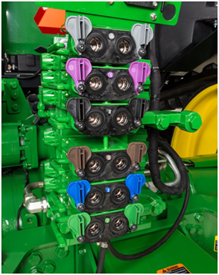 Selective control valve (SCV) stack
Selective control valve (SCV) stackOptional high-flow hydraulics are available on 9 Family Tractors by ordering code 3270. The high-flow hydraulic system provides an additional 215 L/min (57 gpm) of flow for a total of 435 L/min (115 gpm). This system is ideal for hydraulic fan motor demands. This system is recommended for agricultural implements with continuous flow requirements. When maximum hydraulic pump capacity is reached, multiple functions will continue to operate at the same proportional flow rate.
The 9 Family Ag High-Flow Tractors have two parallel hydraulic systems. The benefit of this system is that functions can be split between the two systems. Functions that require high flow and low pressure can be combined on one system (for example, air seeder fans, and planter motors). Functions that require high pressure and low-flow can be connected to the remaining system (for example, implement lift, fold, and constant down-pressure systems).
Following these guidelines allows the hydraulic system to run cooler as it prevents both hydraulic pumps from running at high pressure. In general, pumps forced to run at both high pressure and high flows generate much more heat than a pump running at a lower flow or lower pressure.
The system operates with two hydraulic pumps:
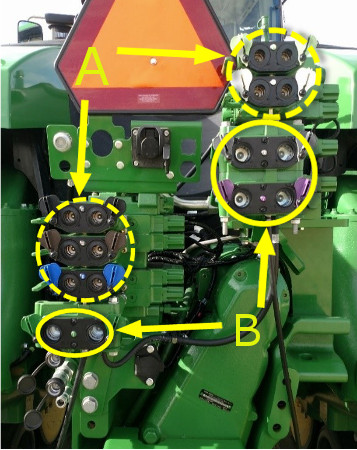 Five 1.3-cm (1/2-in.) couplers (A) and three 1.9-cm (3/4-in.) couplers (B)
Five 1.3-cm (1/2-in.) couplers (A) and three 1.9-cm (3/4-in.) couplers (B)For applications requiring continuous high hydraulic flow or multiple 1.9-cm (3/4-in.) hydraulic connections, this SCV stack is designed to maximize efficiency of the hydraulic system while providing additional flow using 1.9-cm (3/4-in.) couplers. Arrangement of the 1.9-cm (3/4-in.) couplers are split between the tractor’s dual hydraulic pumps to even the hydraulic load on each pump. Increasing coupler size from 1.3 cm (1/2 in.) to 1.9 cm (3/4 in.) allows an additional 26.5 L/min (7 gpm) or 17 percent more hydraulic flow through each coupler and reduces backpressure for hydraulic functions such as dual fan motors associated with the Air Power™ 2 system equipped on John Deere C850 Air Carts. With three 1.9-cm (3/4-in.) couplers available, operators can connect to other high-demand functions such as raise/lower. The 1.9-cm (3/4-in.) couplers also allow higher fan motor speeds for high-rate applications and allow more power to the ground due to less restriction on the hydraulic system.
NOTE: This SCV configuration is available on all double-reduction) axle 9420R to 9570R Tractors with high-flow hydraulics and all 9RX Tractors with high-flow hydraulics. This eight-section SCV stack does not include hydraulic Intelligent Power Management (IPM) software.
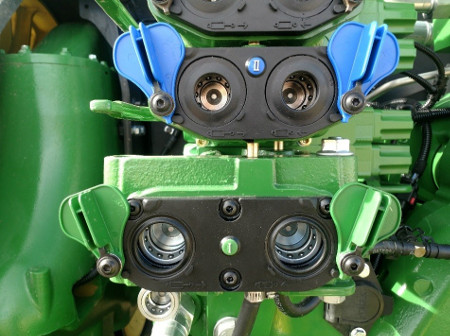 SCV couplers
SCV couplersConnections to 1.3-cm (1/2-in.) and 1.9-cm (3/4-in.) couplers are quick and simple for operators with a split SCV stack configuration at a comfortable connection height.
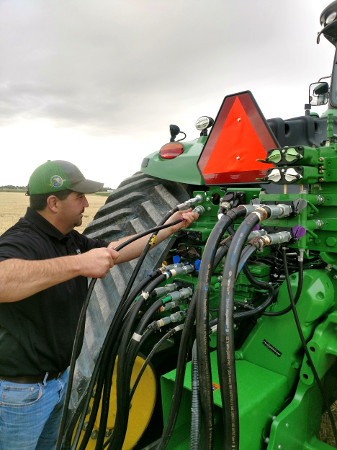 SCV connections in a stack configuration
SCV connections in a stack configuration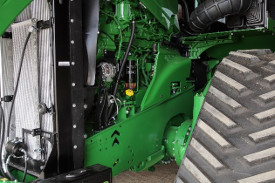 9R, 9RT, and 9RX service access
9R, 9RT, and 9RX service accessRegular service and maintenance are essential to the performance, productivity, and longevity of all farm machinery.
Maximum uptime is an important element of productivity.
All items in the daily service schedule can be performed without the use of tools:
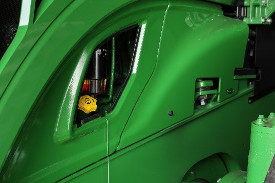 Engine oil service point
Engine oil service point
NOTE: Always refer to the operator’s manual for complete maintenance and service recommendations.
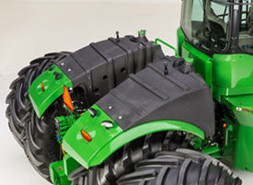 Fuel tank on the 9R
Fuel tank on the 9R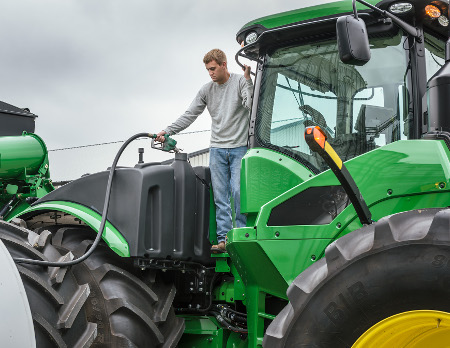 Refueling
RefuelingThe 9R Series Tractors fuel tank is located over the rear axle. The fuel tank features a dual fill design. This design allows the machine to be filled from either side of the fuel tank. A fuel nozzle holder is located when the operator positions themselves on the gudgeon platform to fill the fuel tank.
The diesel exhaust fluid (DEF) tank is located on the left-hand side of the tractor indicated by a blue cap. It is fillable from ground level and has a protective shield to keep debris out of the fill neck.
Model | Diesel | DEF |
9370R | 1211 L (320 gal.) | 120 L (31.7 gal.) |
9420R | 1514 L (400 gal.)* | 120 L (31.7 gal.) |
9470R | 1514 L (400 gal.)* | 120 L (31.7 gal.) |
9520R | 1514 L (400 gal.) | 120 L (31.7 gal.) |
9570R | 1514 L (400 gal.) | 120 L (31.7 gal.) |
9620R | 1514 L (400 gal.) | 120 L (31.7 gal.) |
*When equipped with double-reduction axle. 1211-L (320-gal.) when equipped with single-reduction axle.
9R, 9RT, and 9RX Series Tractors feature an easy-to-use DEF fill system. The 9R and 9RX feature a ground-level fill location, and DEF fill on 9RT is conveniently located on the step platform.
| Machine | DEF tank capacity |
| 9R | 120 L (31.7 gal.) |
| 9RT | 93.9 L (24.8 gal.) |
| 9RX | 120 L (31.7 gal.) |
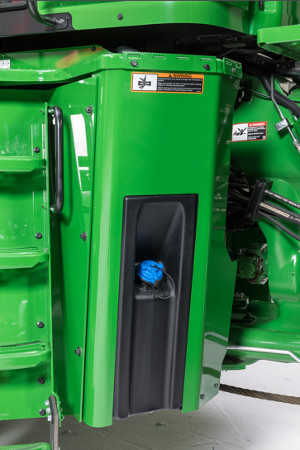 DEF tank on 9R/9RX
DEF tank on 9R/9RX9R, 9RT, and 9RX Series Tractors feature an in-line DEF filter to help protect the DEF pump from any contamination in the DEF tank. This in-line DEF filter is easily serviced with a drain plug to drain any remaining DEF from the filter housing and a replaceable cartridge-style filter.
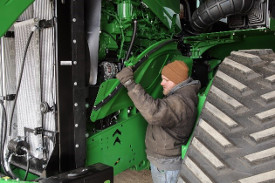 Engine access on 9RX
Engine access on 9RXThe tilt hood and side panel design provides additional engine compartment protection. The 9R, 9RT, and 9RX hoods feature the same design for access to engine components.
Pull out the hood release (located on the front, left side) and tilt hood back to open. Engine side panels are quickly and easily removed for access to periodic maintenance items.
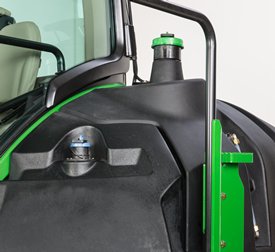 Fuel tank on the left side of 9RT
Fuel tank on the left side of 9RTThe 9RT fuel tank is located behind the cab; the fuel fill is located conveniently on the left-hand main platform.
The 9RT Series Tractors all feature a DEF tank capacity of 93.9 L (24.8 gal.). The fill location is near the diesel fill location.
Model | Diesel | DEF |
9470RT | 1325 L (350 gal.) | 93.9 L (24.8 gal.) |
9520RT | 1325 L (350 gal.) | 93.9 L (24.8 gal.) |
9570RT | 1325 L (350 gal.) | 93.9 L (24.8 gal.) |
Model | Diesel | DEF |
9470RX | 1514 L (400 gal.) | 120 L (31.7 gal.) |
9520RX | 1514 L (400 gal.) | 120 L (31.7 gal.) |
9570RX | 1514 L (400 gal.) | 120 L (31.7 gal.) |
9620RX | 1514 L (400 gal.) | 120 L (31.7 gal.) |
NOTE:
For more information about the use of bio-diesel in John Deere engines, refer to www.JohnDeere.com/biodiesel.
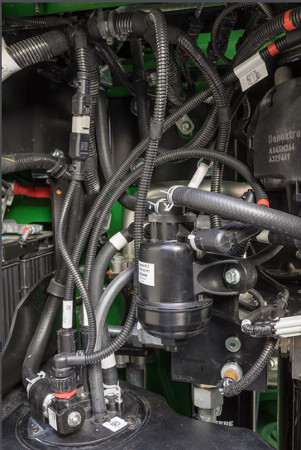 In-line DEF filter
In-line DEF filterSevere-duty water separator, if equipped
The severe-duty water separator can extend service intervals and helps to protect the tractor’s fuel system from damage associated with lower-quality fuel.
Simply open the drain valve on the bottom of the separator and drain accumulated water.
NOTE: Cummins® QSX 15 L (915.4-cu in.) engines cannot be equipped with a severe-duty water separator; however, the fuel filter has separating capabilities like the primary filter on John Deere Power System engines.
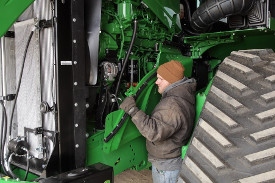 Removing side engine panel
Removing side engine panel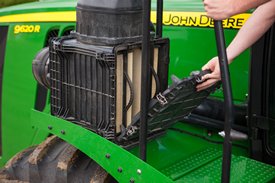 Primary engine air filter inspection
Primary engine air filter inspectionOn the 9R and 9RX, the primary engine air filter is accessible from the left-hand platform for replacement annually or as operating conditions require. The filter is aspirated and extends filter life in dusty conditions by aspirating more than 95 percent of incoming dust. Aspirator suction is created by utilizing the air flow from the cooling fan.
On the 9RT, the primary engine air filter is located at ground level on right side of tractor.
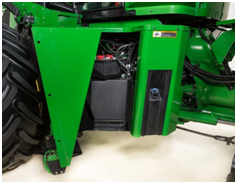 Battery location on 9R and 9RX
Battery location on 9R and 9RX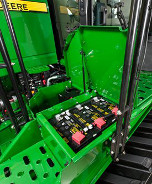 Battery location on 9RT
Battery location on 9RTThe 9R and 9RX battery location is behind the left-hand step assembly. There are three bolts that secure the swinging step assembly that need to be removed to completely access the batteries. The 9RT top step of the platform conceals the tractor’s three 12-V batteries with 2775 CCA (925-CCA each). Tractors with the Cummins X15 engine will have four 12-V batteries in the same location as tractors equipped with John Deere Power System engines.
Although the batteries are maintenance free, conditions such as long periods of operation at high ambient temperatures and excessive engine cranking may require adding water.
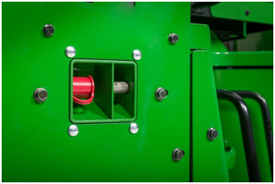 Battery boost terminal
Battery boost terminalOn the 9R and 9RX, a battery boost terminal is located on the left-hand side of the engine for convenient and proper boost assisted starting.
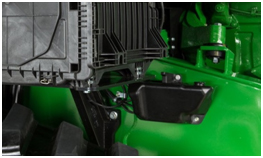 Windshield washer bottle on 9R and 9RX
Windshield washer bottle on 9R and 9RXThe windshield washer bottle is optional on 9R and 9RX Tractors and is located on the left side of the tractor near the DEF fill point. On 9RT Tractors, it is located on the right-side frame.
Maintenance-free U-joint bearings require no servicing to reduce maintenance time.
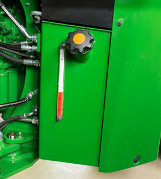 Sight gauge on 9R and 9RX
Sight gauge on 9R and 9RX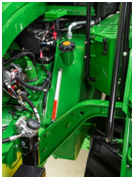 Sight gauge on 9RT
Sight gauge on 9RTA sight glass for the transmission, hydraulic, and axle oil level is located at the back right side of the gudgeon, indicating proper oil levels, and an oil fill neck is located on the back right side of the gudgeon for the 9R and 9RX Series Tractor. The oil fill is located on the top of the common reservoir on the left side of the 9RT Series Tractor and a fill tube is located between the steps and engine of the tractor.
NOTE: The tractor should be off and parked on level ground with the hitch in the lowered position when checking the oil level.
NOTE: Oil level above the top mark on the sight glass can result in power loss and heat generation during transport applications.
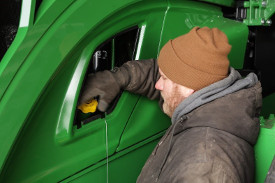 Engine oil check/fill location
Engine oil check/fill locationTractors with the 9.0L (549.2-cu in.) and 13.5L (823.2-cu in.) John Deere Power Systems engines feature a 500-hour change interval when using approved John Deere Plus-50™ II oil and a John Deere oil filter.
Tractors equipped with the Cummins QSX 15-L (915.4-cu in.) engine have a 400-hour engine oil and oil filter change interval.
See the tractor's operator's manual for oil change intervals and further details.
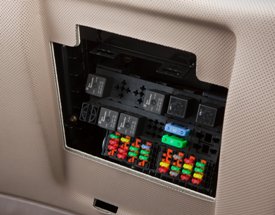 Fuse and relay panel
Fuse and relay panelThe electrical fuse and relay panel is located behind the operator’s seat and just below the cab's rear window. Simply lift up on the operator manual cover for access.
The diode module contains many of the diodes contained in the system:
Electrical system (smart load center)
The electrical system provides a full controller area network (CAN) bus based system on the tractor for improved tractor implement integration and flexibility. Incorporated with the system is a smart load center, which provides fewer fuses, fewer connectors, and simplified wiring for increased reliability.
The solid-state load center’s primary function is to control the majority of high-current loads, such as fender floodlights and the horn. This electronic circuitry will monitor loads and voltages to provide fast reaction time and the ability to alert the operator if a circuit overloads or if voltage is out of specification – for example, open circuit (undercurrent) or short circuit (overcurrent).
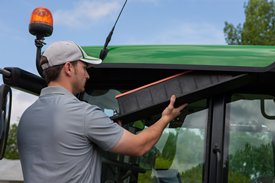 Cab fresh air filter inspection
Cab fresh air filter inspection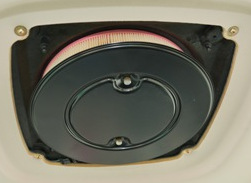 Cab recirculation filter
Cab recirculation filterThe cab fresh air filter is conveniently located beneath the left side of the cab for all 9 Family products:
Cab air recirculation filter
Cab air recirculation filter is located in the roof liner above the operator. 70 percent of the total air volume is recirculated with a blanket effect for enhanced operator comfort.
Cab air filters are not designed to filter out harmful chemicals. Follow the instructions in the implement operator’s manual and those given by the chemical manufacturer when using agricultural chemicals.
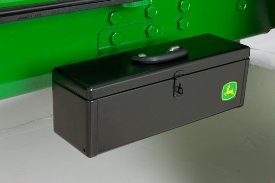 Toolbox for 9R, 9RT and 9RX
Toolbox for 9R, 9RT and 9RXA convenient toolbox is located on the left-hand side of the front frame for tool storage and comes standard on all 9R, 9RT, and 9RX Series Tractors.
9R and 9RX Series Tractors have an additional storage box conveniently located on top the left-hand platform.
The 9RT has an additional toolbox conveniently located next to the left side of the batteries for additional storage.
Cummins is a trademark of Cummins, Inc.
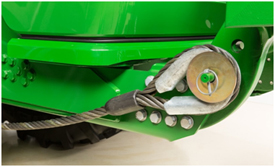 Tow cable front hook
Tow cable front hook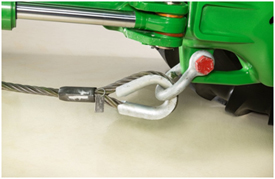 Rear tow cable connection point
Rear tow cable connection pointThe front tow cable is recommended for pulling all 9 Family Tractors in time of needed assistance. Tow cables are available as a factory-installed option on all ag tractors and are base equipment on all Scraper Special Tractors. The tow cable attaches to the area in front of the drawbar and is also available as a field-installed option.
9RX Series Tractors equipped with 45.7-cm (18-in.) and 61-cm (24-in.) tracks feature a maximum speed of 42 km/h (26 mph).
9RX Series Tractors equipped with 45.7-cm (18-in.) or 61-cm (24-in.) tracks are advised to reduce ground speed based on axle load. 9RX Series Tractors equipped with 45.7-cm (18-in.) tracks will have a top speed set at the factory of 31 km/h (19 mph). Maximum speed may be adjusted up to 42 km/h (26 mph) upon review of the transport speed recommendations in the Operator’s Manual.
The speed reduction allows the undercarriage components and tracks to dissipate heat buildup caused by the higher axle loads, reducing undercarriage component and track damage. Increasing mid-roller surface area will increase the undercarriage ability to dissipate heat.
Narrow undercarriage with 45.7-cm (18-in.) tracks feature a narrower mid-roller matched to track width. This results in a smaller mid-roller surface area than 61-cm (24-in.) tracks, which are also matched to track width.
Producers who desire a 9RX machine for row-crop work and who also transport long distances with high axle loads should understand the limitations of the 45.7-cm (18-in.) and 61-cm (24-in.) tracks. 61-cm (24-in.) tracks with a greater mid-roller surface area will provide greater undercarriage and machine performance in transport while maintaining the ability to perform row-crop work. Comparing the transport speed recommendations for 45.7-cm (18-in.) and 61-cm (24-in.) tracks, the speed reduction is higher for 45.7-cm (18-in.) tracks for the same axle load.
9RX Series Tractors with a wide undercarriage and 76.2-cm (30-in.) or 91.4-cm (36-in.) tracks do not feature a speed reduction with increased axle load.
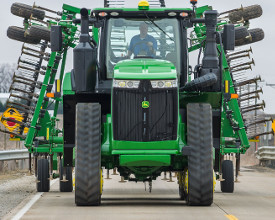 9RX in transport
9RX in transport9RX Series Tractor owners and operators need to be aware of axle loads and the recommended speed. The operator’s manual for both the machine and implement will have information on advised transport speeds. 9RX Series Tractors equipped with narrow undercarriage will also feature an in-cab window decal and reference card stored in the armrest for quick guidance on recommended transport speed based on axle load. Many implements may have a lower recommended transport speed than the tractor,; it is always advised to follow the lowest recommended transport speed.
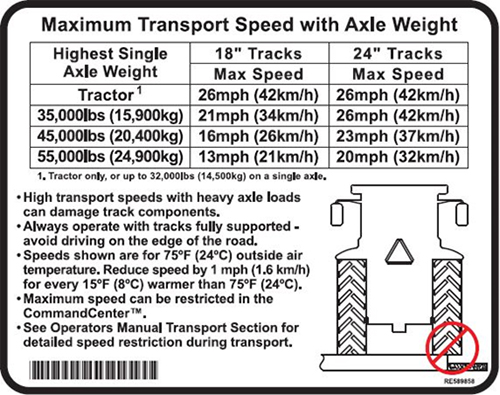 Maximum transport speed with axle weight
Maximum transport speed with axle weight| 1 mph increment | |||||||
| Single axle weight | 18 inch track max. | Single axle weight | 24 inch track max. | ||||
| (kg) | (lbs) | km/h | mph | (kg) | (lbs) | km/h | mph |
| 14,500 | 32,000 | 42 | 26 | 16,800 | 37,000 | 42 | 26 |
| 15,000 | 33,000 | 37 | 23 | 18,100 | 40,000 | 40 | 25 |
| 15,400 | 34,000 | 35 | 22 | 19,500 | 43,000 | 39 | 24 |
| 15,900 | 35,000 | 34 | 21 | 20,900 | 46,000 | 37 | 23 |
| 16,300 | 36,000 | 32 | 20 | 22,200 | 49,000 | 35 | 22 |
| 17,200 | 38,000 | 31 | 19 | 23,600 | 52,000 | 34 | 21 |
| 18,100 | 40,000 | 29 | 18 | 24,900 | 55,000 | 32 | 20 |
| 19,500 | 43,000 | 27 | 17 | 27,200 | 60,000 | 31 | 19 |
| 20,900 | 46,000 | 26 | 16 | ||||
| 22,200 | 49,000 | 24 | 15 | ||||
| 23,600 | 52,000 | 23 | 14 | ||||
| 25,400 | 56,000 | 21 | 13 | ||||
| 27,200 | 60,000 | 19 | 12 | ||||
| Application | Implement | Payload | Total tractor | Rear axle load (lbs) | Front axle load (lbs) | 18 inch (mph) | 24 inch (mph) |
| Other | 60' 2410C applicator | 400 | 61,400 | 30,000 | 32,000 | 26 | 26 |
| Primary Tillage | 9 shank 2720 (without rolling baskets) | 500 | 61,500 | 30,000 | 32,000 | 26 | 26 |
| Primary Tillage | 11 shank 2730 (gangs, without rolling baskets) | 484 | 61,484 | 30,000 | 32,000 | 26 | 26 |
| Secondary Tillage | 45' 2210LL cultivator | 1100 | 62,100 | 31,000 | 31,000 | 26 | 26 |
| Secondary Tillage | 40' 2623 VT | 1800 | 62,800 | 32,000 | 31,000 | 26 | 26 |
| Other | 60' 2510L 2400 gal (empty) | 3608 | 64,608 | 34,000 | 30,000 | 22 | 26 |
| Other | 1100 bu grain cart empty (Kinze 1100) | 3950 | 64,950 | 35,000 | 30,000 | 21 | 26 |
| Secondary Tillage | 45' 2310 mulch finisher | 4200 | 65,200 | 35,000 | 30,000 | 21 | 26 |
| Other | 1500 bu grain cart empty (Brent Avalanche 1596) | 3800 | 64,800 | 35,000 | 30,000 | 21 | 26 |
| Other | 1000 bu grain cart loaded (Brent 1082) | 4710 | 65,710 | 36,000 | 30,000 | 20 | 26 |
| Other | 1500 bu grain cart empty (Kinze 1500) | 5250 | 66,250 | 37,000 | 30,000 | 19 | 26 |
| Other | 1500 bu grain cart empty (Brent Avalanche 1596) | 5500 | 66,50 | 37,000 | 30,000 | 19 | 26 |
| Other | 1100 bu grain cart loaded (Kinze 1100) | 6280 | 67,280 | 38,000 | 29,000 | 19 | 25 |
| Other | 1100 bu grain cart loaded (Kinze 1500) | 7380 | 68,380 | 39,000 | 29,000 | 18 | 25 |
| Planters | DB60 47R15 CCS | 8340 | 69,340 | 41,000 | 29,000 | 17 | 24 |
| Planters | DB90 Planter | 12,300 | 73,300 | 46,000 | 27,000 | 16 | 23 |
| Planters | 1775NT 24R drawbar (need to verify) | 13,000 | 74,000 | 47,000 | 27,000 | 15 | 22 |
| Planters | DB120 Planter | 17,600 | 78,600 | 54,000 | 25,000 | 13 | 20 |
| Other | Hitch load | 15,000 | 76,000 | 54,000 | 22,000 | 13 | 20 |
NOTE: Example implements are for reference and direction only. Weigh the tractor and the amount of weight on the axle to determine the final recommended speed. Weights of implements will vary due to different configurations available between tractor and implement. Never exceed the maximum speed recommendation of any implement.
For producers who wish to limit vehicle top speed, transmission settings can be adjusted on the CommandARM™ display or user profiles can be established which locks out the ability to change vehicle top speed by the operator unless they enter the PIN.
| Window decal | |||||
| Single axle weight | 18 inch track max. | 24 inch track max. | |||
| (kg) | (lbs) | km/h | mph | km/h | mph |
| Tractor | 42 | 26 | 42 | 26 | |
| 15,900 | 35,000 | 34 | 21 | 42 | 26 |
| 20,400 | 45,000 | 26 | 16 | 37 | 23 |
| 24,900 | 55,000 | 21 | 13 | 32 | 20 |
Beginning with model year 2019 production, 9RX Series Tractors equipped with 76.2-cm (30-in.) and 91.4-cm (36-in.) tracks can be equipped with industry-exclusive, factory-installed track spacing set at 304.8-cm (120-in.).
9RX Series Tractors equipped with 304.8-cm (120-in.) track spacing provide increased stability, allow producers to operate on 304.8-cm (120-in.) centers for controlled traffic farming, and provide improved track-to-frame clearance for better access to the undercarriage for serviceability and material cleanout. John Deere is the first and only tractor manufacturer to offer a 304.8-cm (120-in.) track spacing option on four-track tractors with 76.2-cm (30-in.) and 91.4-cm (36-in.) tracks up to 462.3 kW (620 hp).
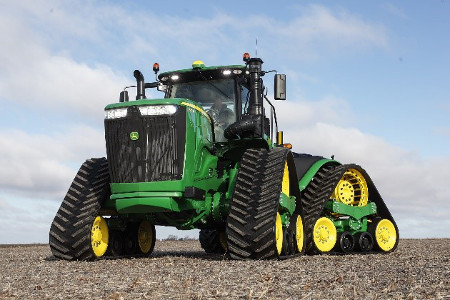 9RX with 91.4 cm (36 in.) tracks and 304.8-cm (120-in.) track spacing
9RX with 91.4 cm (36 in.) tracks and 304.8-cm (120-in.) track spacing9RX Series Tractors with 304.8-cm (120-in.) track spacing increase space between the undercarriage and chassis to provide more space for performing daily and routine maintenance tasks.
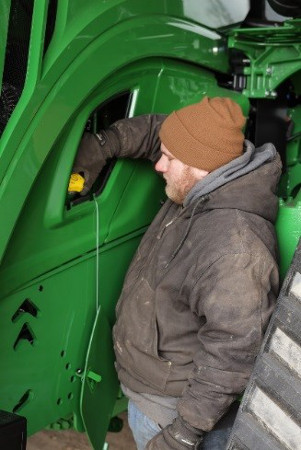 Performing daily maintenance tasks
Performing daily maintenance tasks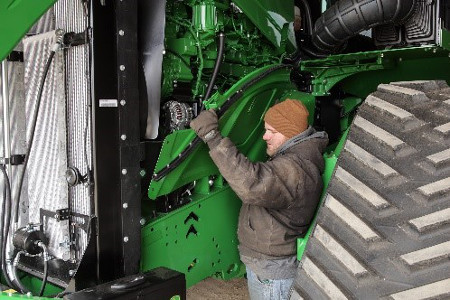 Performing routine maintenance tasks
Performing routine maintenance tasks| 9RX Series Tractors undercarriage configurations | ||||
 |  | |||
| Model | Narrow undercarriage | Wide undercarriage | ||
| Track spacing: 203.2 cm (80 in.), 223.5 cm (88 in.), or 304.8 cm (120 in.) | Track spacing: 223.5 cm (88 in.) or 304.8 cm (120 in.) | |||
| 45.7 cm (18 in.) tracks | 61 cm (24 in.) tracks | 76.2 cm (30 in.) tracks | 91.4 cm (36 in.) tracks | |
| 9420RX | • | • | --- | --- |
| 9470RX | • | • | • | • |
| 9520RX | • | • | • | • |
| 9570RX | --- | --- | • | • |
| 9620RX | --- | --- | • | • |
• Available
--- Not available
Compare the specifications of up to 4 models
| Key Specs | 9470rx-track-tractor Current Model |
|---|---|
| Engine description | John Deere PowerTech™ PSS 13.5L (B20 diesel compatible) |
| Engine displacement | 13.5 L 824 cu in. |
| Rated engine power | 346 kW 470 hp |
| Rated PTO power (hp SAE) | 249 kW 335 hp |
| Transmission type | Standard: John Deere e18™ 18-speed PowerShift with Efficiency Manager™: 40 km/h 25 mph |
| Hydraulic pump rated output | Standard: 220 L/min 58 gpm Optional: 435 L/min 115 gpm |
| Rear hitch category (SAE designation) | Category 4N/3: 6,804 kg 15,000 lb Category 4N/3: 9,072 kg 20,000 lb Category 4N/4: 6,804 kg Category 4N/4: 9,072 kg |
| Base machine weight | NArrow undercarriage: 23,587 kg 52,000 lb Wide undercarriage: 24,494 kg 54,000 lb |
| Maximum PTO power | |
| Maximum engine power | |
| Engine specifications | |
| Description | John Deere PowerTech™ PSS 13.5L (B20 diesel compatible) |
| Engine type | Diesel, in-line, 6-cylinder, wet-sleeve cylinder liners with 4 valves-in-head |
| Engine family | JJDXL13.5310 |
| Rated speed | 2,100 rpm |
| Aspiration | Dual series turbocharger with fixed geometry first stage - variable geometry second stage - air-to-air aftercooling and cooled exhaust gas recirculation |
| Cylinders liners | |
| Emission level | Final Tier 4 |
| After treatment type | DOC/DPF/SCR |
| Displacement | 13.5 L 824 cu in. |
| Engine performance | |
| Rated power | 346 kW 470 hp |
| Rated PTO power (hp SAE) | 249 kW 335 hp |
| Power boost | 10 percent |
| Engine peak torque | At 1,600 rpm: 2,169 Nm 380 lb-ft |
| PTO torque rise | 38 percent |
| Intelligent Power Management (available in transport and/or mobile PTO applications) | |
| Maximum PTO power | |
| Maximum engine power | |
| Transmission | |
| Type | Standard: John Deere e18™ 18-speed PowerShift with Efficiency Manager™: 40 km/h 25 mph |
| Reverser | |
| Clutch; wet/dry | |
| Creeper | |
| Hydraulic system | |
| Type | Closed-center, pressure/flow compensated |
| Pump rated output | Standard: 220 L/min 58 gpm Optional: 435 L/min 115 gpm |
| Available flow at a single rear SCV | 0.5 in. couplers: 132 L/min 35 gpm |
| Available flow at front SCVs | |
| Number of rear selective control valves (SCVs) | Standard: ISO Couplers: 4-6 Optional: ISO Couplers: 7-8 (field installed) |
| Number of mid selective control valves (SCVs) | |
| Number of front selective control valves (SCVs) | |
| Joystick SCV control | |
| SCV control | Electronic |
| Rear hitch | |
| Hitch draft control load sense type | |
| Remote control valves available | |
| Hitch category (SAE designation) | Category 4N/3: 6,804 kg 15,000 lb Category 4N/3: 9,072 kg 20,000 lb Category 4N/4: 6,804 kg Category 4N/4: 9,072 kg |
| Maximum lift capacity behind lift points | Category 4N/4: 9,072 kg 20,000 lb |
| Sensing type | Electrohydraulic with draft sensing |
| Rear axle differential lock | |
| Lift capacity at standard frame | |
| Drawbar | |
| Drawbar category | Standard: Category 5 Optional: Category 5 with heavy duty support Category 4 conversion kit |
| Maximum vertical load | Standard: 5,440 kg 12,000 lb |
| Rear power take-off (PTO) | |
| Type | Independent 44 mm (1.75 in.) 20-spline, 1,000 rpm |
| Engine rpm (at rated PTO speeds) | |
| PTO actuation | |
| Ground speed PTO option availability | |
| Multispeed PTO option availability | |
| Front hitch | |
| Category | |
| Electric power | |
| Standard lift capacity | |
| Front power take-off (PTO) | |
| PTO speed | |
| Rear axle | |
| Type | |
| Final drive type | Bull gear and double idler with floating pinion |
| Differential controls | |
| Axle type | |
| Brakes, type and control | |
| Rear differential lock | Full-locking electrohydraulic |
| Load rating | |
| Front axle | |
| Type | |
| Front axle differential lock | Full-locking electrohydraulic |
| Load rating | |
| Tires | |
| Front | Tracks: 457 mm 18 in. Tracks: 609 mm 24 in. Tracks: 762 mm 30 in. Tracks: 914 mm 36 in. |
| Rear | Tracks: 457 mm 18 in. Tracks: 609 mm 24 in. Tracks: 762 mm 30 in. Tracks: 914 mm 36 in. |
| Wheel tread range | Narrow undercarriage: 2032 mm 80 in. 2235 mm 88 in. 3048 mm 120 in. Wide undercarriage: 2235 mm |
| Turning radius with brakes | |
| Turning radius without brakes | 6,400 mm 21 ft |
| Steering | |
| Type | Standard: Hydraulic power-steering Optional: ActiveCommand™ Steering (ACS) |
| Electrical system | |
| Alternator size | Standard: 200 amp Optional: 240 amp |
| Battery options | 12 V |
| Total cold cranking amps | 925 CCA |
| Type of bulb in beacon (Halogen, Zenon, LED) | |
| Type of bulb in headlight (Halogen, Zenon, LED) | |
| Working lights | |
| dB(A) rating for backup alarm | |
| Operator station | |
| Rollover protective structure, OOS | |
| Seat | ComfortCommand™ |
| Cab suspension | Standard |
| Instructional seat | Standard |
| Display | Standard: 4100 Generation 4 CommandCenter™ with 7 in. display Optional: 4600 Generation 4 CommandCenter™ with 10 in. display |
| Radio | Standard: AM/FM stereo with weatherband, remote controls, auxiliary input jack, four speakers and external antenna |
| Inner cab volume | 3.597 m3 127 cu ft |
| dB(A) rating | |
| Cab glass area | 6.52 m2 70.18 sq ft |
| Front visibility | |
| Safety glass rating | |
| Dimensions | |
| Wheelbase | 4,128 mm 162.5 in. |
| Overall length | Excluding hitch: 7,637 mm 300.7 in. Including hitch and coupler: 8,217 mm 323.5 in. |
| Drawbar clearance | 403 mm 15.9 in. |
| Front axle center | |
| Approximate shipping weight, Open;Cab | Narrow undercarriage: 23,587 kg/m3 52,000 lb Wide undercarriage: 24,494 kg 54,000 lb |
| Overall height | |
| Weight | |
| Base machine weight | NArrow undercarriage: 23,587 kg 52,000 lb Wide undercarriage: 24,494 kg 54,000 lb |
| Maximum ballast level | 28,122 kg 62,000 lb |
| Maximum permissible weight | |
| Capacities | |
| Crankcase oil volume | 48 L 12.7 U.S. gal. |
| Fuel tank | 1,514 L 400 U.S. gal. |
| Diesel exhaust fluid (DEF) tank | 83 L 22 U.S. gal. |
| Cooling system | 56.5 L 14.9 U.S. gal. |
| Transmission-hydraulic system | With 3-point hitch and PTO: 227 L 60 U.S. gal. Without 3-point hitch and PTO: 220 L 58 U.S. gal. |
| Serviceability | |
| Interval for engine oil change | 400 hours |
| Interval for hydraulic/transmission oil change | 1,500 hours |
| Interval for engine coolant change | 6,000 hours |
| Loaders | |
| Loader | |
| Lift capacity at full height | |
| Maximum lift height | |
| Precision AG | |
| Guidance | AutoTrac™ Ready |
| Telematic | Available with JDLink™ hardware, activations, and Ethernet Harnesses (availability dependent upon destination) |
| Remote diagnostics | Available with activated JDLink hardware and activations |
| Miscellaneous | |
| Country of manufacture | USA |
| Side slope rating | |
| Uphill/downhill slope rating | |
| Tracks | |
| Drive type | |
| Midrollers | |
| Track width | |
| Tread spacing |
© COPYRIGHT 2025 LEGACY EQUIPMENT - ALL RIGHTS RESERVED| Privacy Policy | Powered By